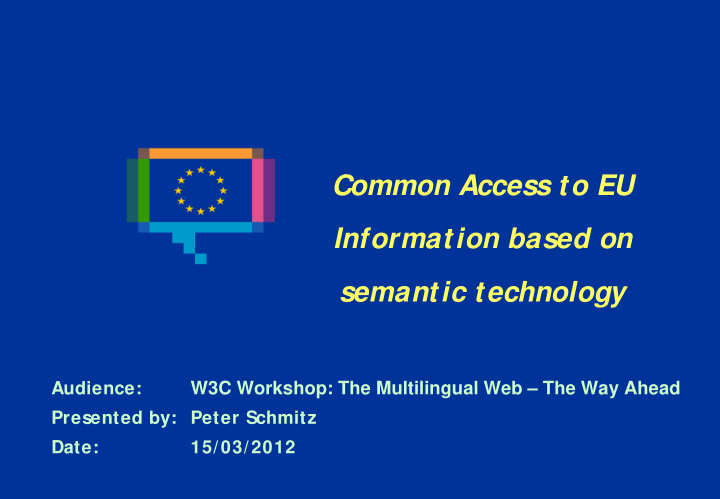



Common Access to EU Information based on semantic technology Audience: W3C Workshop: The Multilingual Web – The Way Ahead Presented by: Peter Schmitz Date: 15/03/2012
2 Table of content Who is the Publications Office of the EU? Common access to EU information based on semantic technology - CELLAR Proj ect Vision and target architecture Use of semantic technology Multilingual aspects Interoperability
3 Who is the Publications Office of the EU? In summary: From the EU to the public
Who is the Publications Office of the EU? 4 What do we publish? “Official” publications Other “ general” publications
5 Who is the Publications Office of the EU? Key production indicators for 2011 • Official Journal of the European Union • 866 issues, 22/ 23 languages, five days a week, 1.065.425 pages • 411.850 public procurement notices • Consolidation of EU Law (52.097 legislative acts) • General publications • 5.972 titles, official languages of the EU, but also other languages Disseminat ion • Paper copies • Online services Long-term Preservation • Paper archive • Digital archive
6 Who is the Publications Office of the EU? Main public online services
7 CELLAR Proj ect: Vision To make available at a single place all metadata and digital content managed by the Publications Office in a harmonised and standardised way in order: • To guarantee to the citizen a better access to law and publications of the European Union; • To encourage and facilitate reuse of content and metadata by professionals and experts; • To preserve content and metadata and access to contents and metadata over time.
8 CELLAR Proj ect: Target architecture
CELLAR proj ect: Use of semantic technology 9 Common data model: Ontology based on FRBR model FRBR = Funct ional requirement s for bibliografical records
CELLAR proj ect: Use of semantic technology 10 Metadata represented in RDF
CELLAR proj ect: Use of semantic technology 11 Taxonomies represented in S KOS
12 CELLAR project: Multilingual aspects Example: Multilinguism enabled by coded metadata EUROVOC 007984 007130 002081 002739 004036 004074 005070
13 CELLAR proj ect: Interoperability Adoption of standards • METS ( Metadata encoding and transmission standard ) -> ingestion protocol • Dublin Core -> core metadat a definition • FRBR compliant -> data model/ ontology • Linked Open Data (LOD) -> access/ reuse • Web-friendly ("RES Tful") Interface • RDF / OWL • S tandard Query Language (S PARQL) -> access/ reuse
14 CELLAR proj ect: Interoperability Definition of standards Core metadat a ( Restricted shared set of metadata for each resource based on Dublin Core ) -> enable global search Common authority tables -> harmonize metadat a Exchange protocol for EU legislative procedures -> interoperability Under preparation: European Legislative Identifier (ELI) ( initiative of EU member countries, supported by the Publications Office) -> interoperability
15 Thank you for your attention!
Recommend
More recommend